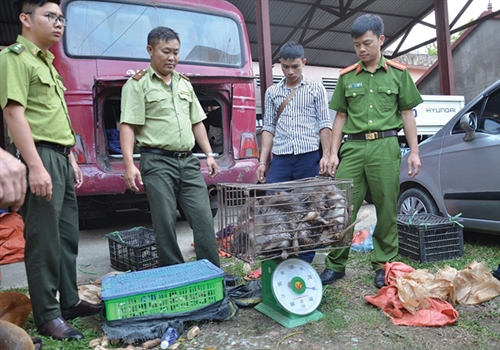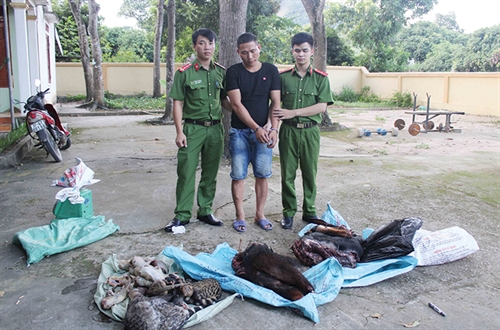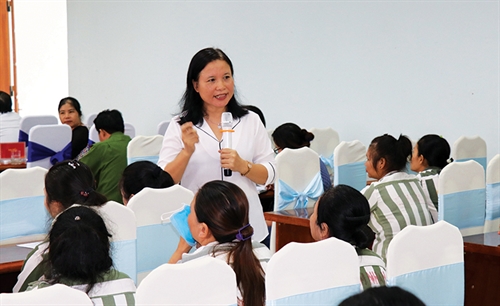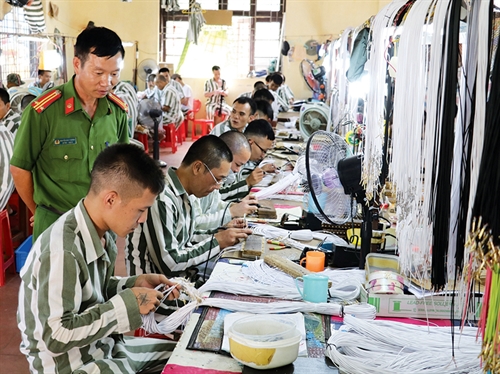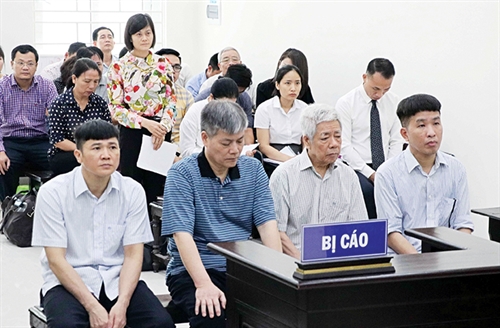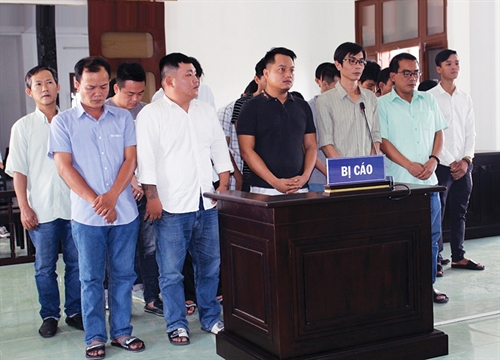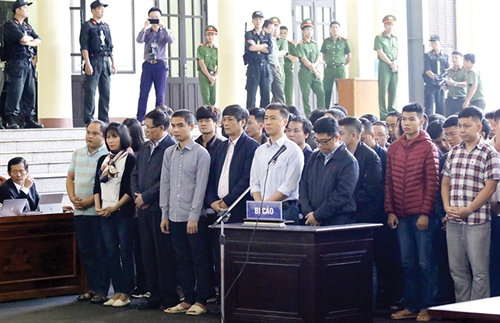Dao Le Thu, Ph.D
Comparative Law Institute
Hanoi Law University
This paper outlines the remarkable evolution of juvenile justice in Vietnam. It discusses the extent to which Vietnamese juvenile justice and related laws and policies have been shaped by identifiable ideologies and models of intervention. Moreover, the legal framework governing juvenile justice, mainly the 2016 Law on Children, the 2015 Penal Code, the 2015 Criminal Procedure Code and the 2010 Law on Execution of Criminal Judgments, is introduced to show the complex and scattered state of relevant legislation. The paper offers a short analysis of actors who perform the juvenile justice role or function and reveals a system without specialization or clear separation from the justice system for adult offenders. In addition to identifying emerging characteristics of the system, the author compares these with some typical juvenile justice models around the world, namely the welfare model, the justice model and the restorative model, and concludes that the Vietnamese model is a hybrid mixture of these three ones. Finally, the author makes some recommendations on shaping the juvenile justice system of Vietnam in conformity with international standards in order to meet access-to-justice needs of Vietnamese juvenile offenders.
Introduction
Different from developed countries where issues concerning juvenile justice have been discussed for a long time, Vietnam has really begun to consider these issues since the enactment of some relevant legislation. Therefore, attention has increasingly been paid to juvenile justice over the recent years. The protection of children’s rights is usually the focus of these considerations. Juvenile justice is now receiving greater attention on the part of key justice actors, policy makers, and social and legal scientists. Vietnamese lawmakers, law enforcement officials and legal scientists have been building and developing key elements of a juvenile justice system.
As the author is concerned with the extent to which Vietnam can be said to have a real juvenile justice system and what are its main characteristics, this paper examines juvenile justice in Vietnam in both its historical and present contexts in order to retrace its evolution and reveal the ideology or philosophy that guided its development and compare it to common juvenile justice models around the world.
Background
This year marks the 30th anniversary of the adoption of the United Nations Convention on the Rights of the Child (the Convention). Vietnam was the second country in the world to ratify the Convention and then to implement it by enacting the 1991 Law on Child Protection, Care and Education (revised in 2004) and the 2016 Law on Children. Other important Vietnamese legislation, including some relating to criminal justice, show the country’s determination to implement and comply with the Convention.
Vietnamese juvenile justice should be considered in the context of the country’s considerable policy reforms dealing more generally with justice for children and resulting in innovative amendments to the Penal Code, the Criminal Procedure Code, and the Law on Organization of People’s Courts, among others.
In addition to the relevant legal reforms, the establishment in Vietnam of a special tribunal for cases involving children, called the Family and Juvenile Tribunal, as a juvenile justice system foundation, has encouraged a greater engagement of juvenile justice researchers and practitioners in further development of a specialized juvenile justice system.
This is all happening in a context where there is a perceived increase in juvenile delinquency, especially as it relates to theft, robbery, crimes against the person, and drug-related crimes.[1] Juvenile delinquency has become a pressing social issue due to public concerns about serious cases connected with juvenile activities and involving considerable loss of life. According to statistics released by the Ministry of Public Security and the Supreme People’s Court, as well as surveys conducted by the Supreme People’s Procuracy, the prevalence and seriousness of juvenile delinquency have both slowly but steadily increased in the country.[2] A provincial court’s chief justice has warned about the alarming situation of juvenile offending, showing both the rise in number of cases and their increasing seriousness. He also quoted a statement by the ex-director of the Hanoi Police Department which estimated that out of one million offenders, there may be as many as 200 thousands under-30 people, or 20 percent of the total.[3] When facing such a worrying situation while significant legislative reforms are taking place, one must ask what has not worked and why. This situation has urged legal scientists and practitioners to search for different approaches to juvenile crime prevention and juvenile justice reform.
 |
| Le Van Luyen, who committed a crime while being under 18 years old, was sentenced to 18 years in jail in 2012 Photo: Internet |
Historical evolutions
In the past, in Vietnamese law, juveniles were not considered to have their own legal standing. In other words they were not identified by the law as rights bearers. However, this did not mean that they were completely ignored. Before the country regained its independence in 1975, juvenile justice did not receive due attention. During the war time, the family was mainly responsible for its children. The State only began to take real steps in preventing and handling juvenile offenses after the reunification of the country.
It is not easy to identify the initial steps of Vietnamese juvenile justice as these appeared quite blurred in the justice history. The root of juvenile justice can be traced back to the year of 1964 with the founding of Kim Dong[4] schools under the Ministry of Education which were responsible for education of naughty and disorderly children (children at risk). This system of schools then developed to become public schools managed by the Ministry of Public Security under the Prime Minister Resolution 217-TTg-NC dated December 18, 1967,
resulting in better prevention of juvenile delinquency.[5] Before the establishment of these schools, the idea of treating juveniles differently and more favorably than adults first appeared in Decree 181 dated June 12, 1951, of the Ministry of Home Affairs and the Ministry of Justice, on organization of detention facilities, by the provision that suggested (not required) separate detention of juveniles (Article 9). No other legislation or institution concerning juvenile justice existed in this period of time. It can be said that in the period between 1960s and 1970s the legal focus was only on raising children correctly and making them follow society’s rules.
In spite of the court’s awareness about the need for a legal framework to deal with juvenile cases, one of the biggest obstacles to access to juvenile justice was the lack of legislation governing this aspect.[6] No provision ever existed regulating the age of criminal liability or exclusion of certain penalties for juvenile offenders. As a result, juveniles who committed crimes would be treated as adult offenders. Fortunately, the Supreme Court tried to guide the court system to rule cases involving juvenile offenders with some degree of tolerance and recognition of juveniles’ limited legal capacity. For example, it directed that courts only consider imposing penalties on juveniles who had reached the age of at least 14 years, setting up a principle of proportionality between the age of juveniles and the level of penalty, arguing against unnecessary imposition of capital punishment and in favor of limiting life imprisonment to be imposed on juvenile offenders.[7]
The next important step was one that reflected a radical change in approaching to juvenile delinquency, the enactment of the 1985 Penal Code which realized the significance of special criminal law dispositions for juvenile offenders and devoted a whole chapter (Chapter VII) to govern such issues as the age of criminal liability, basic principles of handling criminal activities committed by juveniles, penalties and judicial measures applicable to juvenile offenders, reduction of the duration of penalty execution, and revocation of criminal records for convicted juveniles. The first Criminal Procedure Code, passed in 1988, also set up a meaningful mechanism of separate criminal procedures for juvenile defendants in Chapter XXXI.
After the enactment of the first Penal Code and Criminal Procedure Code, juvenile justice history continued with the first special law on children. In 1991, one year after becoming a state party to the Convention, the National Assembly of Vietnam passed the Law on Child Protection, Care and Education in order to address children issues separately from adults. The law was revised in 2004 and superseded by the Law on Children in 2016.[8]
Children’s opinions were part of what motivated lawmakers to proceed with reforms. Before the passage of the Law on Children, policy and law makers had received a number of questions and opinions expressed by children in forums and conferences.[9] Children had called for legal provisions to protect their rights, including to right to participate and express their view in any judicial and administrative proceedings affecting them, and this was reflected in the new law.
However, these laws maintained the definition of the child as someone aged under 16 years. Until recently, lawmakers have been hesitant to change this definition to include children up to the age of 18 years.[10] One of objectives of the revision of the Law on Child Protection, Care and Education after 10 years of implementation is to make the concept of a child to be more compliant with international standards. However, in some respects, it failed to do so.
Another remarkable step with respect to juvenile justice of Vietnam was taken in 2014 when the National Assembly passed the revised Law on Organization of People’s Courts that provided for the establishment of the Family and Juvenile Tribunal. The establishment of this special tribunal aimed to comply with international obligations under the Convention, fully support children to participate in legal proceedings, promote a greater specialization in handling children issues, ensure that the principle of the best interests of the child is applied, support child-friendly approaches during juvenile justice proceedings, and facilitate the involvement of social workers and the social welfare sector.[11]
The criminal legislation (both substantive and procedural) has continuously evolved around the notion of separate and tolerant treatment of juveniles. It culminated in new provisions on diverse measures in the 2015 Penal Code and child-friendly principles and proceedings in the 2015 Criminal Procedure Code. The 2015 Criminal Procedure Code also further broadens its procedural safeguards for victims and witnesses who are under 18 years old. The criminal legislation has subsequently stepped toward diversion, restorative justice for juvenile offenders and child-sensitive approach to all children in contact with the law.
Cultural and social factors that influenced juvenile justice of Vietnam
When talking about a country’s juvenile justice system, a question must be raised, which is what are cultural and social factors that influence its establishment and development. One may also identify a number of ideological factors that affected the development of juvenile justice in Vietnam.
Vietnamese juvenile justice has been deeply affected by traditional ideologies, but also recently inspired by the western jurisprudential ideas. It reflects a mixture of the goodness and tolerance-oriented culture which resulted from Confucianism and Buddhism, the ideology toward children’ interests of President Ho Chi Minh, the communist ideology and some models of juvenile justice that have been commonly applied all over the world.
Based on President Ho Chi Minh’s ideology and the Communist Party of Vietnam’s resolutions, the Supreme Court in the 1970s provided guidance on the handling of criminal cases involving juveniles, noting that the prime purpose of interventions was to educate and prevent juveniles from further conflicts with the law, and reiterating responsibilities of various state agencies, social organizations and families. It also required that the recourse to criminal proceedings and imposition of criminal penalties should be considered only as the last resort and that criminal penalties should be imposed in a balanced manner and integrated with treatment and education measures. The Supreme People’s Court also reminded lower courts that they should impose less severe sentences on convicted juveniles as compared to adults convicted of similar crimes in similar circumstances.[12]
New ideas and different attitudes toward juvenile justice of Vietnam discussed over the recent years came from the National Assembly, media, legal and social sciences as well as law practitioners, focusing on criminal policy and criminal substantive law relating to juvenile offenders. Most of these discussions were concerned with the scope of criminal liability of juveniles, expressing many lawmakers’ support for limiting the range of offenses for which juveniles can be found criminally responsible. Others, however, argued in favor of maintaining the broader scope provided in the 1999 Penal Code.[13] Before the 2017 revision of the Penal Code, there were discussions relating to the minimum age of criminal liability. Some legal experts and law enforcement officials even suggested the minimum age be lowered. For example, a chief Justice expressed his concern that there had been several cases where children were known to have committed murder or some other serious crimes, but were not held criminally responsible because they had not yet reached the age of 14, and suggested the minimum age be lowered.[14] Some extreme points of view supported the idea that children should be treated in the same way as adults, ignoring the developmental nature of childhood. Some of these views probably resulted from recent high-profile juvenile delinquency cases where juveniles committed serious murders and gross assaults.[15]
Other opinions seemed to support the idea of due treatment in order to protect public order and security, raising the importance of protection of public interests more than those of juveniles. A judge said that he was worried by the low level of imprisonment terms imposed on juvenile offenders due to the relevant provisions of the Penal Code. He also referred to what he perceived as a growing social concern with and reaction to these issues.[16] This shows that many law practitioners did not agree that juvenile offenders should be treated or punished less severely. They focused, instead, on a narrow notion of the principle of proportionality that would require penalties to be proportional to seriousness of offenses, without regard to circumstances of offenders and the principle of due process, thus neglecting to consider the need to treat juvenile offenders in a manner that takes into account their level of development. This clearly opposes the severe penalty doctrine to that of the tolerant treatment doctrine in the juvenile justice history.
Public education and awareness improvement have progressively changed the public perception of children, from seeing them as “miniature adults” to considering them as persons whose moral judgment and cognitive capacities are not yet fully developed. Public perception of juvenile justice has also recently improved, tending to focus on welfare of children and support for a educational and restorative approach.
Diversion and restorative justice are relatively new concepts in Vietnam, but they are receiving increased attention. One may be somewhat optimistic to hear the view that such issues as the protection and care of juveniles, prevention and investigation of juvenile crime, and application of substantive criminal law to juvenile delinquency must balance both legal and public safety concerns as well as humanitarian principles. There is also a positive notion that the effective prevention of juvenile crime and effective responses to juvenile delinquents should be educational, rehabilitative and restorative rather than relying solely on punishment.[17] Furthermore, this progressive point of view sees the need to structure a juvenile justice system to include not only juvenile courts but also specialized investigation and prosecution authorities. It also holds that specialized law enforcement officials who are specially trained in dealing with children should be involved in juvenile justice cases. In addition to, and in conformity with, those separate and specialized institutions, a set of special legal proceedings satisfying requirements of the criminal policy, the principle of tolerance, psychological and social characteristics of juveniles is also necessary.[18] Last but not least, legal officials are also concerned with aftercare measures. They call for reintegration programs for convicted juveniles to ensure their continuous transfer from the reform schools or detention institutions to their families and community in order to keep good habits and behaviors they got from such institutions and make these stable and developed in the community.[19]
By analyzing ideas and opinions from legal sectors and experts in Vietnam, one can identify cultural factors that stand out as relevant to the nature of modern juvenile justice: sympathy, mutual protection and help, and support. The traditional ideology’s influence on Vietnamese juvenile justice is apparent as it is combined with other cultural factors to play an important role in raising awareness about juveniles and forming juvenile justice components. For instance, the “child-friendly” approach is a new development in policies and laws on juveniles in contact with juvenile justice of Vietnam that calls for consideration of juvenile and social needs for forgiveness to “soften” the need for justice.
Ideology of restorative justice is playing an increasingly important role in Vietnamese juvenile justice. The theories and practices of restorative justice around the world have been introduced into Vietnam in the 2010s, initiated and strongly supported by UNICEF Vietnam. This makes Vietnamese people think about juvenile offenders with more empathy. Hopefully, they will also be more oriented toward reconciliation between juvenile offenders and victims in particular and community in general.
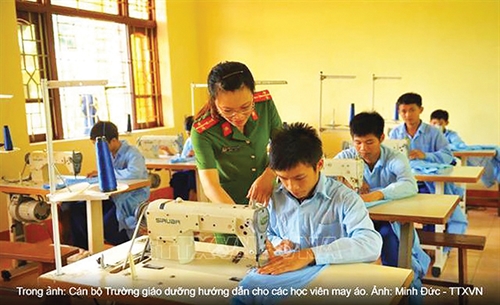 |
| Juvenile offenders learn textile basic knowledge at reformatories__Photo: Minh Duc/VNA |
The legal framework in place
Vietnam now has a huge number of laws and regulations governing issues relating to justice for children in general and handling cases concerning children in conflict with the law in particular.
The ultimate one is of course the 2013 Constitution. Its Article 37 provides for the highest protection of children’s rights by confirming rights of children to protection, care and education provided by their families, the State and society and allowing children to participate in decisions that concern them. This Article also strictly prohibits activities of maltreatment, abandonment and abuse of children and exploitation of child labor as well as other forms of violation of children’s rights.
In addition, Vietnam’s 2016 Law on Children (the Law) pays much attention to children referred to as children in special circumstances, including children in conflict with law and other vulnerable children. By its provisions on principles for ensuring children’ rights and many other provisions in terms of justice for children which mainly focus on protection of children, the Law purports to (i) ensure the right to defense and legal aid for children; (ii) ensure timely prevention, assistance and intervention measures that are safe, continuous, adequate, flexible and suitable to the needs, circumstances, age, psychological and physiological characteristics of children, while taking into account and respecting opinions, aspiration, emotion and attitudes of children; (iii) ensure the close coordination among agencies, organizations, child protection services, families, educational institutions and procedural agencies or administrative violation-handling agencies; and, (iv) protect the privacy of children.
Article 70 of the Law enumerates 10 rights-based requirements that must be satisfied for the protection of vulnerable children and juveniles in legal proceedings, handling of administrative offenses and social reintegration. These requirements are meant to ensure that a child is fairly and equally treated and respected in keeping with his/her age and level of maturity, and to prioritize the quick settlement of cases involving a child in order to minimize physical and mental harms to him/her. Those provisions also aim to ensure the provision of assistance to children’s parents, guardians or lawful representatives throughout the legal proceedings or handling of administrative violations as well as to protect lawful rights and interests of children. These further require persons conducting criminal/civil proceedings or competent to handle administrative offenses, lawyers and legal officers to have sufficient psychological and educational knowledge concerning children and use friendly and easy-to-understand language with children.
Article 71 of the Law provides protective measures to be taken to protect juvenile offenders and assist their reintegration into their families and the community. Meanwhile, Article 72 establishes the responsibility of commune-level child protection officers in legal proceedings and in the process of handling administrative violations, namely providing information on children and their circumstances to competent persons, providing counseling, information and guidance to children and their parents on how to access to assistance, and monitoring and supporting the execution of administrative sanctions at the commune level, among others.
With respect to administrative justice, the 2012 Law on Handling of Administrative Violations devotes a dedicated part (the Fifth Part) on administrative handling measures to deal with violating juveniles. Its Articles 133 to 137 specify policies and measures applicable to administrative juvenile violators. Article 134 establishes principles on imposing administrative sanctions against juvenile violators, including the need of considering alternative measures to administrative sanctions. The alternative measures include admonition (warning) and management at home (Articles 138-140). It is worth noting that juveniles subject to alternative measures are not to be deemed administratively sanctioned at all. As compared to the 2002 Ordinance on Handling of Administrative Violations, the 2012 Law is far more supportive of a specialized approach to handling juvenile cases and introduces a number of new child-sensitive provisions.
Similarly, the criminal legislation has made important progress in protecting the rights of juvenile offenders. The 2015 Penal Code (revised in 2017) maintains a separate chapter (Chapter XII) that exclusively applies to persons aged under 18 years at the time of committing an offense, and improves the treatment of these offenders, especially by acknowledging the importance of the principle of the best interests of the child, in an attempt to achieve better compliance with international standards and norms. Moreover, the Penal Code recognizes for the first time supervisory and educational measures for under-18 offenders who are exempted from criminal liability. These measures are somewhat similar to diversion measures adopted in other countries. In addition to the Penal Code, the 2015 Criminal Procedure Code sets out principles on application of child-friendly criminal procedures, significantly stating that criminal procedures must be child-friendly, appropriate for the juvenile age and level of cognitive maturity, help protect lawful rights and interests of juveniles and guarantee the best interests of juveniles (Article 414.1).
The 2014 Law on Organization of People’s Courts lays grounds for establishment of a special court for children-related cases, named the Family and Juvenile Tribunal. This tribunal has jurisdiction to adjudicate cases in which crimes are committed by juveniles or victims of crimes are aged under 18 years and seriously suffered from psychological harm or children who need living and educational facility support due to their lack of common family environment. It also has jurisdiction to impose administrative sanctions on juveniles that commit administrative violations in cases settled by people’s courts.[20]
Regarding the management of rehabilitation and social reintegration of juvenile offenders, the 2010 Law on Execution of Criminal Judgments affirms the principle that the execution of criminal judgments against convicted juveniles is mainly to educate and support in order to help them become mature and good persons for the society (Article 4.5). It also grants authority and responsibility to prisons, detention facility managers and criminal judgment execution agencies of district-level public security divisions to work closely with offenders’ families, local administrations, relevant agencies, organizations and individuals in encouraging juvenile inmates to keep up good spirit in training themselves to receive parole granted by the State and in providing education and vocational training support for these inmates and preparing them for community reintegration (Article 39.2).
However, the legal framework for access to justice for juveniles still contains shortcomings and impractical provisions. For instance, the Law on Children just focuses on the aspect of protection of children, juvenile justice is not its priority. Likewise, the Law on Handling of Administrative Violations contains an impractical provision requiring the application of alternative measures (in substitution for administrative sanctions) to juveniles. Particularly, as per Article 140.1.a, alternative measures namely admonition and management at home require their parents or guardians satisfy some conditions, including voluntarily taking care of and controlling juvenile offenders at home. These requirements can hardly be met by juveniles’ circumstances due to the fact that juveniles usually commit administrative violations for they lack family care and education, their parents’ divorce or their parents being criminals themselves.[21] The 2015 Penal Code also requires application of supervising and educational measures in cases of exemption from criminal liability, consequently letting juveniles bear more responsibilities than others who are also exempted from criminal liability. This Code does not even take into account the guarantee for application of these measures.
It can be concluded that Vietnam does not yet have a separate and comprehensive law to govern the administration of juvenile justice. In short, although the country has many laws and regulations dealing with juvenile justice issues, these do not yet amount to form a realistic and effective approach to preventing juvenile crime.
Actors involving in juvenile justice in Vietnam
The juvenile justice system is established to cover a range of agencies and actors, including the legislative, administrative and judicial branches. Specifically, the National Assembly and People’ Councils at all levels are responsible for making laws, policies, programs and plans in order to implement and protect the rights of children. They also have authority to supervise and review the management and enforcement of children’s rights. Meanwhile, the Government and its ministries and agencies are responsible for administration of justice for children in general and juvenile justice in particular. Specifically, the Ministry of Labor, Invalids and Social Affairs, Ministry of Justice and Ministry of Public Security and some related functional agencies are key actors with a clear duty to manage children rights issues.
With regard to juvenile justice, the most directly involved actors are investigative bodies (under the Ministry of Public Security), procuracies and courts. The 2015 Criminal Procedure Code requires them all to have capacities and skills to work with, or have knowledge about, children in conflict with the law (Article 415). However, in practice most cases involving juvenile offenders have been handled by public security officers, procurators and judges who are not trained to deal with such vulnerable subjects. Enforcement officials usually have little knowledge about psychology and educational science and do not have required skills to work with children. Many of them even seem to resist the idea of considering the best interests of children as the prime principle guiding their actions and decisions.
As one of its conclusions, a recent report conducted by UNICEF and the Ministry of Justice admitted that the role of families, agencies and organizations in supervising children remains symbolic, with limited availability of support services such as counselling, mentoring, life skills training, vocational training, etc.[22]
From the author’s point of view, these actors and their agencies neither form a systemic structure nor function as a specialized system. This is partly responsible for ineffectiveness of juvenile justice of Vietnam.
What model does Vietnamese juvenile justice reflect?
In order to identify the model that inspired the Vietnamese juvenile justice, it is necessary to review briefly some of the most common models that prevail around the world. It is worth noting that countries may be different in the way of building their own juvenile justice systems while sharing common ideologies and models that appear most suitable to them.
Historically, the two most influential theoretical models of juvenile justice have been the welfare model and the justice model. The welfare model emphasizes rehabilitation needs of offenders. The justice model emphasizes due process and accountability.[23] Later the third model, referred to as the restorative justice, has appeared to be widely applied since it meets the needs and demands of both criminals and victims and really solve their conflicts. Over the recent years, some of distinctions between these models have become blurred.
The welfare model is based on the idea of rehabilitation so it also be called rehabilitative model. It can be traced back to the enactment of the Children Act of England in 1908 which was based on the doctrine of parens patriae - the British doctrine that considers the Royal as parent of the country. The model highlights the right of the State to intervene in the life of a child differently from the life of an adult. It is interpreted as the right of the King (state) to provide protection for persons who were not of full legal capacity. It focuses on care and treatment rather than punishment and control, while making punishment and rehabilitation become inseparable. The shortcoming of this model is the lack of adequate parental protection due to the fact that it is mainly based on the role of public authorities and state welfare.[24]
The justice model is based on the idea of punitive treatment while ensuring the due process principle. Countries that apply this model have implemented policies that treat juvenile offenders in the same ways as adult offenders, as long as they ensure all their lawful rights in the process of handling juvenile cases. The shift from the welfare model to the justice model was caused by the considerable rise in juvenile delinquency in many countries after the Second World War. Risks of juvenile crime to society, the danger to the public, and the importance of victims’ interests argued for the application of this model.[25]
The debates over the welfare versus justice models for juvenile justice have been illustrated by a process of simultaneous broadening of welfare concerns, as well as the promulgation of the ideology of the justice model. Young people are seen as being in need of guidance and assistance (the welfare aspect), while at the same time offending is seen to be the result of calculated decisions by rational actors (the justice aspect).
A third approach, the restorative model, is currently emerging as an influence of lawmakers. This model encourages offenders to accept responsibility for their criminal behavior and its consequences for others.[26] One of the key features of the model is the involvement of victims in dealing with the offense. It does not overlook rehabilitation and punishment but places them in the context of individuals taking responsibility for their actions. The paradigm of restorative justice argues that criminal behavior is a conflict between individuals and that when a crime is committed, it is the victim who is harmed rather than the State. Thus, rather than the offender owing a debt to society which must be expunged by experiencing some form of punishment (such as a fine or imprisonment), the offender owes a debt to the victim, which can only be repaired by making good to damage caused to that particular individual. The aim of the process is to bring about reconciliation, not to exact punishment. The restorative model is often integral to diverting young offenders from the formal court system. It is a contextual model that acknowledges desirability of balancing juvenile offenders’ rights against their responsibilities to the community. It considers that national standards for juvenile justice should strike a balance between the rehabilitation of offenders and restitution to the victim and the community. It seeks to deal with underlying causes of offenses and to integrate offenders and their families into society by involving all significant parties in the offense and the life of the juvenile offender.[27]
Looking back to the beginning of juvenile justice of Vietnam, the feature of the State’s intervention in children’ lives and their families shows an aspect of the welfare model. This was clearly illustrated by the Supreme People’s Court’s holding in its evaluation of the enforcement of penalties and measures to juvenile offenders, that the application of coercive educational measures such as reform schooling on children in conflict with the law not only fulfilled rehabilitation requirements but also met general prevention requirements.[28]
Juvenile justice of Vietnam in the period before the enactment of the first criminal law could be identified by features of both models, welfare and justice. The State tried to solve juvenile conflicts by the system of reform schools, whilst did not establish any special law or regulation on, or any specialized authority responsible for, juvenile issues.
Recently such concepts as diversion, restorative justice, child-friendly or child-sensitive approach have inspired juvenile justice of Vietnam. The influence has not only been shown in the 2015 Penal Code and the 2015 Criminal Procedure Code, but also in the establishment of the two first juvenile courts as well as the application of some models of administration of juvenile justice by communities. Some models within communities for community reintegration of juveniles after leaving rehabilitation facilities, such as clubs of grand parents and children initiated by the Vietnam Fatherland Front and model of reintegration of children in conflict with the law piloted by the Faculty of Women Studies of the Open University and the People’ Committee of Commune 4, District 4 of Ho Chi Minh City, have now been working effectively.[29] However those concepts are still new in Vietnam, thus having no real impact on awareness of competent authorities and officials. It just raises a question about whether Vietnam has adequate mechanisms that allow for restorative juvenile justice.
The absence of a specialized juvenile justice system is a fundamental barrier to the development of comprehensive juvenile justice as well as the implementation of the restorative justice model. The second problem is general perception. On the one hand, the public reaction and attitude to juvenile crime and the media reporting of particular serious cases can lead to a more punitive approach by competent authorities. On the other hand, it is still difficult to be aware of the fact that a child in conflict with the law is no longer a passive subject that needs assistance, but an active subject who has the rights to full protection and active participation. In addition, key actors of the traditional criminal system may be sceptical of effectiveness of informal justice since they do not have adequate and precise knowledge about advantages of restorative justice and diversion measures applicable to children.
Juvenile justice of Vietnam has considerably changed over the recent years. It can be identified by some restorative justice features but these need to be strengthened and developed.
Some recommendations
First of all, there is no doubt that children need their own justice system that meets requirements of at least the best interests of the child. Building a separate system of juvenile justice, including a law on juvenile justice and separate and specialized training authorities should be one of priorities in the near future. A number of fundamental principles based on the rights of the child, including the principle of the best interests of the child, should guide efforts to develop juvenile justice of Vietnam.
To apply restorative model effectively, national standards for juvenile justice should stress the importance of rehabilitation of offenders and restitution to victims and the community. The role of the community as a whole and some specific associations should be enhanced in order to give more effective contributions to juvenile justice. Organizations such as the Communist Youth Union or Vietnam Women’s Union should be supportive actors in the implementation of formal measures and main actors in the application of alternative measures. In cooperation with their families, there should be also participation of educational and welfare institutions to help juveniles reintegrate themselves into society. Supportive measures can be assistance, training and psychological application.
It is also necessary to intensify training of professionals in the area of juvenile justice, especially to build capacity to deliver more child-sensitive interventions.
In facing increasing public concerns over juvenile crime and violence, Vietnamese juvenile justice has to balance between public complaints and special demands and needs of juveniles.
Juvenile justice development should center around (i) maximizing diversion from the court system; (ii) minimizing penetration into the formal justice system; and (iii) encouraging public support and involvement.
Like many other countries, Vietnam is facing issues of resources, including resources to invest in restorative justice programs, provide training and capacity building to professionals in contact with children in the course of restorative proceedings, carry out data collection and comparative analysis, and build monitoring systems that can evaluate effectiveness of restorative justice practices. These difficulties therefore call for contributions from different sectors and communities. Delivering juvenile justice lessons and doing research on the theme will be efforts among these contributions.
Conclusion
Juvenile justice of Vietnam has seen some considerable improvements over the recent years, thanks to an increased awareness of the importance of legal institution reforms. However, these improvements are neither systematic nor comprehensive.
The Vietnamese juvenile justice system is still in transition and further reforms are needed. There remains a need for a special law on juvenile justice based on a comprehensive policy and model, a separate system of specialized training, well trained and specialized skilled actors to deal with children in conflict with the law, and greater engagement of the community in the prevention of and response to juvenile crime.-
[1] See UNICEF (Vietnam) and the Ministry of Justice of Vietnam, Situational Analysis of Vietnam’s Juvenile Justice System, Hanoi 2019; see also Trinh Thi Kim Ngoc, The rise of juvenile delinquency – An urgent warning to our country’s sustainable social development (Tinh trang gia tang toi pham o nguoi chua thanh nien – Mot canh bao cap thiet voi phat trien ben vung xa hoi o nuoc ta), Journal of Human Research, No. 2, 2013.[2] See for example a range of news by the Online Newspapers of People’s Representatives that provide updated statistics by these authorities, information accessed on 12/5/2019 at http://daibieunhandan.vn/default.aspx?tabid=81&NewsId=393390 and http://www.daibieunhandan.vn/default.aspx?tabid=81&NewsId=412179[3] See Pham Minh Tuyen, Prevention of juvenile delinquency by the courts through the adjudication of criminal cases - results, shortcomings and causes (Phong ngua toi pham nguoi chua thanh nien cua Toa an thong qua hoat đong xet xu cac vu an hinh su - Ket qua, nhung bat cap han che va nguyen nhan), accessed on 8 May, 2019, at: http://hvta.toaan.gov.vn/portal/page/portal/hvta/27676686/27677461?p_page_id=27677461&pers_id=28346379&folder_id=&item_id=96168833&p_details=1[4] Name of a legendary young hero of Vietnam.[5] People’s Supreme Court, “Special issue summarizing experiences of adjudication of juvenile criminal cases” in Systematization of Criminal Law, Book II (1975-1978), Hanoi - 1979, at 28-29.[6] Ibid., at 30.[7] Ibid., at 38-50.[8] See for more detail in The Ministry of Labour, Invalids and Social Affairs, Report on Overall Evaluation of 10 years of Enforcement of the Law on Child Protection, Care and Education, No.59/BC-BLDTBXH, dated June 15,2015, accessed on 10/5/2019 at: http://duthaoonline.quochoi.vn/DuThao/Lists/DT_DUTHAO_LUAT/View_Detail.aspx?ItemID=657&TabIndex=2&TaiLieuID=2240[9] See for example recommendations given by children in the Third National Children Forum in 2013 Information accessed on May 14, 2019 at: http://duthaoonline.quochoi.vn/DuThao/Lists/TT_TINLAPPHAP/View_Detail.aspx?ItemID=1397[10] See for example the opinion given by Mr. Truong Trong Nghia, a National Assembly deputy, in National Assembly plenary session on March 23, 2016, on discussion of the draft Law on Children. He was suspicious of the need to broaden the age of a child under the Law. Information accessed on 10 May 2019 at http://duthaoonline.quochoi.vn/DuThao/Lists/TT_TINLAPPHAP/View_Detail.aspx?ItemID=2516[11] See for example UNICEF and the People’ Supreme Court of Vietnam, Overview Report on theoretical and practical bases of the establishment of juvenile courts in Vietnam, the Youth Publisher, Hanoi 2012.[12] People’s Supreme Court, “Special issue summarizing experiences from the adjudication of juvenile criminal cases” in Systematization of Criminal Law, Book II (1975-1978), Hanoi - 1979, at 35-36.[13] See for example the news on discussion of specialized National Assembly deputies on two plans of providing the age of criminal liability, accessed on 12/5/2019 at: https://www.tienphong.vn/phap-luat/hai-phuong-an-ve-do-tuoi-chiu-trach-nhiem-hinh-su-1136525.tpo[14] See Pham Minh Tuyen, supra note 3.[15] For example the opinions to impose life imprisonment or even death penalty on Le Van Luyen, the juvenile murderer who intentionally killed four people in a family in Bac Giang province in 2011. A summary of these opinions can be found at https://giaoduc.net.vn/Xa-hoi/Ban-an-du-luan-danh-cho-sat-thu-Le-Van-Luyen-post12977.gd. Information accessed on 12/5/2019.[16] See Pham Minh Tuyen, supra note 3.[17] See: Nguyen Anh, “Juvenile Justice in Vietnam”, the Online Journal of the People’s Supreme Court, updated on February 2, 2018, accessed on 8 May 2019 at: https://tapchitoaan.vn/bai-viet/tin-quan-tam/tu-phap-nguoi-chua-thanh-nien-o-viet-nam[18] See Tran Van Do, “Researching the establishment of juvenile courts in Viet Nam” in UNICEF and the People’ Supreme Court of Vietnam, Overview Report on theoretical and practical bases of the establishment of juvenile courts in Vietnam, the Youth Publisher, Hanoi 2012, at 121.[19] See Nguyen Van Hoan, Reintegration into community for juvenile offenders (Tai hoa nhap cong đong cho nguoi chua thanh nien vi pham phap luat), accessed on 10/5/2019 at https://luathinhsu.wordpress.com/2009/11/25/tai-hoa-nhap-cong-dong-doi-voi-nguoi-chua-thanh-nien-vi-pham-phap-luat/. Also Nguyen Khac Hai and Y. Dandurand (2019). Social Reintegration of Offenders (Tai hoa nhap xa hoi doi voi nguoi pham toi), Social Science Human Resources (Nhan luc Khoa hoc Xa hoi), Thematic Issue No. 1 (May 2019) on Policies and Law Pertaining to Criminal Judgment Execution: Theories and Critical Practical Issues. Van Cam, L., Dandurand, Y. and N. K. Hai (2009). Vietnam-Canada Research Collaboration in Criminal Law and Criminology - Towards an Agenda. Law and Development Journal, N2/2009.[20] See for more details the People’s Supreme Court’s Circular No. 01/2016/TT-CA dated January 21, 2016, on organization of special courts within local courts.[21] See Tu Vuong, Difficulties in handling administrative violations of juveniles (Vuong mac trong xu ly vi pham hanh chinh doi voi nguoi chua thanh nien vi pham phap luat), accessed on 6 May 2019, at: https://kiemsat.vn/vuong-mac-trong-xu-ly-hanh-chinh-doi-voi-nguoi-chua-thanh-nien-vi-pham-phap-luat-51379.html[22] UNICEF (Vietnam) and the Ministry of Justice of Vietnam (2019), Situational Analysis of the Vietnam Juvenile Justice System, Hanoi.[23] These models and their application were discussed in detail in ALRC Sentencing Research Paper 11 named Sentencing Young Offenders AGPS Canberra 1988, Chapter 4. See also I. O’Connor ‘Models of Juvenile Justice’ in A. Borowski & I. O’Connor (eds), Juvenile Crime, Justice and Corrections, Longman, Sydney 1997.[24] See Harry R. Dammer, Jay S. Albanese, Comparative Criminal Justice Systems, Wadworth Cengage Learning, Fifth Edition, 2014, at 286.[25] See Harry R. Dammer, Jay S. Albanese, Comparative Criminal Justice Systems, Wadworth Cengage Learning, Fifth Edition, 2014, at 286.[26] See F. McElrea, ‘Restorative justice – the New Zealand Youth Court: A model for development in other courts?’, (1994) 4 Journal of Judicial Administration, at 33.[27] See Chomil Kamal, Directions of Juvenile Justice Reforms in Singapore, Research Papers delivered at 118th International Training Course Visiting Experts’ Papers, Resource Material Series No. 59, at 114.[28] People’s Supreme Court, “Special Issue summarizing experiences from the adjudication of juvenile criminal cases” in Systematization of Criminal Law, Book II (1975-1978), Hanoi - 1979, at 39.[29] See Nguyễn Văn Hoàn, Reintegration into community for juvenile offenders (Tái hòa nhập cộng đồng cho người chưa thành niên vi phạm pháp luật), accessed on 10/5/2019 at https://luathinhsu.wordpress.com/2009/11/25/tai-hoa-nhap-cong-dong-doi-voi-nguoi-chua-thanh-nien-vi-pham-phap-luat/

